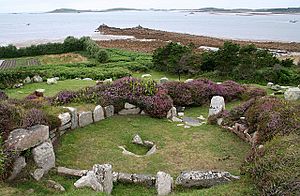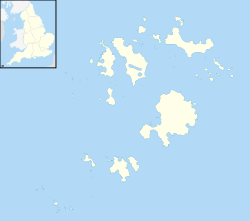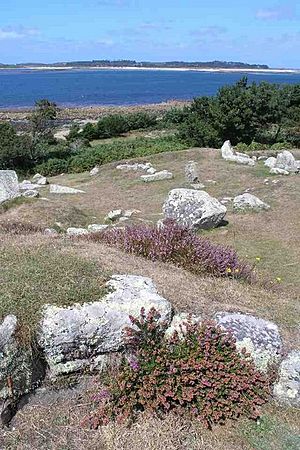Halangy Down facts for kids

Halangy Down Ancient Village
|
|
| Region | Isles of Scilly |
|---|---|
| Coordinates | 49°55′55″N 6°18′23″W / 49.93194°N 6.30639°W |
| History | |
| Founded | Iron Age |
| Periods | Iron Age, Roman-Britain |
Halangy Down (also known as Halangy Down Ancient Village) is an amazing old settlement. It is found on St Mary's island, which is part of the Isles of Scilly. This ancient site sits on the lower part of Halangy Down hill. From here, you can look out over the water between St. Mary's and Tresco Island.
At this site, you can see the remains of an Iron Age village. There are also two special burial places called entrance graves. You can also find very old field systems, tall standing stones, and even some old walls from later times. A Victorian pit used for making soap from kelp is also there. People lived in this village for about 500 years. This was from the late Iron Age until the end of the Roman rule in Britain.
Contents
Exploring Halangy Down Ancient Village
Halangy Down is a hill on St. Mary's island. At the very top of the hill, on its southwest side, is an ancient burial site. This site is called Bant's Carn and is an entrance grave. It looks out over the water between St. Mary's and Tresco Island.
What You Can See at the Village
Below Bant's Carn, further down the hill, are the remains of the Iron Age village. This is the "Halangy Down Ancient Village." The village area is about 50 meters (55 yards) long and 30 meters (35 yards) wide. It spreads across four narrow, flat areas on the lower part of the hill. The old village shows that people lived here all the way from prehistoric times to the Roman period in Britain. Another entrance grave is located at the bottom of the hill.
Ancient Fields and Structures
Between the Bronze Age grave and the village, you can still see parts of old field systems. These look like a series of flat steps and raised banks. You can imagine how the village once looked by seeing the large stone ruins. These are what's left of stone huts, buildings, and a courtyard with many rooms.
At the bottom of the northwest slope, there is a very old standing stone. It is made of granite. This stone is about 1.75 meters (5 feet 9 inches) tall. It is 1 meter (3 feet 3 inches) wide and 0.7 meters (2 feet 3 inches) thick.
Later Additions to the Site
Behind the edge of the cliff, there are some low walls and ditches. These were built in the mid-1600s and were used during the English Civil War.
From the late 1600s to the early 1800s, people made soda-ash on Halangy Down. They did this in a special stone-lined pit called a kelp pit. This pit is about 2.5 meters (3 yards) from the cliff edge. It is easy to spot as a round, stone-lined hollow. The pit is 1.4 meters (4 feet 8 inches) across and 0.6 meters (2 feet) deep. It is shaped like an upside-down cone.
History of Halangy Down Settlement
People first settled at Halangy Down Ancient Village during the Bronze Age. Archaeologists are like history detectives. They dug up the site in 1935, 1950, and from 1964 to 1970. Their discoveries showed that the first stone buildings were made during the Iron Age. This period was from about 800 BC to 100 AD.
How the Village Changed Over Time
Evidence shows that the buildings were often changed and rebuilt. This happened over the 500 years that people lived there. This period stretched from the late Iron Age to the Roman time in Britain. Roman rule was from 43 AD to 410 AD. The village was made up of many stone houses connected together. One house was very large. It had many rooms and a courtyard. This big house was built during the Romano-British period.
What Archaeologists Found
When they dug, archaeologists found many interesting things. They found pottery from the Iron Age, Roman-British, and Anglo-Saxon times. They also found tools made of flint and quartz. A special spinning tool called a slate spindle-whorl was found. Several millstones for grinding grain were there too. They also found bronze brooches (like pins) and iron slag, which is waste from making iron.
Early Houses and Later Developments
In the early days, the village had oval or round stone houses. These houses had thick walls. Their roofs were cone-shaped and made of thatch. Small storage spaces were built right into the walls. The houses were built with large stones and rubble. The size of these houses varied. Some were 7.5 meters (25 feet) by 5.1 meters (16 feet). Others were 7 meters (23 feet) by 6.75 meters (22 feet 2 inches). The houses usually had one or two entrances. These were faced passages up to 2.2 meters (7 feet 3 inches) wide.
In the later stages of the village, a large courtyard complex was built. This was at the southeast end of the settlement. It included a big house with many rooms. The complex had several rooms leading off a small courtyard. A huge wall surrounded the entire complex. You entered the complex through a narrow passage.
Daily Life Clues
Next to the northwest wall of the courtyard house, archaeologists found a large midden. A midden is like an ancient rubbish dump. This one had a huge pile of limpet shells. Limpets are small sea snails. Other things found in the midden included bones from fish, cattle, sheep, pigs, and horses. These finds help us understand what people ate and how they lived long ago.



